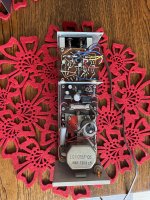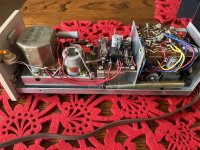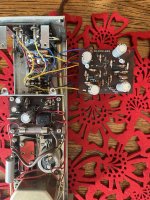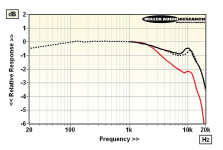Yes, in theory the KA-9021 is not as good as a line stage output, but sounding pretty good nonetheless. Definitely worth pursuing. KE-9021 works well in a Micro Seiki MA-505S tonearm.
I might get a chance to measure voltages this weekend. There's a hum in the left channel; I should probably recap the KA-9021 before going much further.
I might get a chance to measure voltages this weekend. There's a hum in the left channel; I should probably recap the KA-9021 before going much further.
I've made an opamp version (gain 24) with 30+50hz filter, and a tube version with embedded 50hz filter.
Tube diagram is for right channel, left channel just to flip the transformer pin for non-inverted output.
BTW, I prefer E1 over ART9, and 003 easily wins ZYX Airy.


Tube diagram is for right channel, left channel just to flip the transformer pin for non-inverted output.
BTW, I prefer E1 over ART9, and 003 easily wins ZYX Airy.
Last edited:
uesugi lab released a new production with very interesting features,
1. current amplifier instead of resistor based I/V (similar idea as 47 lab phono cube?)
2. new phono cable with external power supply, splitting out the signal and LED power ground (ideally to split right at cartridge clip?)
3. LED inner force detection (to help adjust anti-skating?)
Attached pdf translated from Japanese.
1. current amplifier instead of resistor based I/V (similar idea as 47 lab phono cube?)
2. new phono cable with external power supply, splitting out the signal and LED power ground (ideally to split right at cartridge clip?)
3. LED inner force detection (to help adjust anti-skating?)
Attached pdf translated from Japanese.
Attachments
Remind me how much the cartridge is?
Entry level is mid $2.5K... DS-E1 cartridge and equalizer.
Thank you very much for the pictures and the initial voltage measurements - much appreciated.Initial measurements:
KA-9021 lamp voltage supply is 5.6VDC and the amplifier circuit is 4.3VDC.
Is the lamp voltage supply meant as the voltage supply to the optoelectric KE-9021cartridge lamp - or lamp for the preamp pilot light ? Has been the cartridge connected to the preamp while making these voltage measurements ?
Yes the 5.6VDC lamp voltage supply is for the KE-9021 cartridge lamp in the cartridge. I haven't traced the circuit for the pilot light on the preamp, but it may be 100V AC. On my preamp the bulb appears to be open circuit.
I did not measure the pilot light voltage, it works without it...
The cartridge was connected when making voltage measurements. I will post further findings when I get time.
I found a cold solder joint which may be the cause of the hum in the left channel. Next I will power the circuit from a 6VDC battery with a dropper diode and measure current.
By the way, congrats on your cartridge purchase. Is it the one I saw on Yahoo Japan in the last month?
I did not measure the pilot light voltage, it works without it...
The cartridge was connected when making voltage measurements. I will post further findings when I get time.
I found a cold solder joint which may be the cause of the hum in the left channel. Next I will power the circuit from a 6VDC battery with a dropper diode and measure current.
By the way, congrats on your cartridge purchase. Is it the one I saw on Yahoo Japan in the last month?
Thank you for the clarification.
Yes, in any equipment that might even approach vintage status, cold solder joints are to be suspected - and dealt with ASAP.
I had a nasty one of those in the equipment from your neck of woods - Perreaux SM-2 preamp. The thing would power up, maybe start working, after flyby of the tiniest insect it would pick its vibration ... - and quit.
Turned out to be an oxidized wire of the mains transformer under what appeared to be a proper solder joint. The nastiest of cold solder joint stuff.
Thanks for the congrats on the cartridge purchase - yes, it was the one on Yahoo Japan most recently. TBH, it has been an enforced buying decision - after checking what else might be of interest on Yahoo Japan after scoring the "Objet de desire" I have been originally after. I did not even know that Trio ( or anyone else prior to recent-ish DS Audio offerings ) made a 1/2" mounting center photo cartridge - with replaceable stylus to boot...
I had less than 12 hours to scour the net for any info on the cart prior the end of the auction.
Both Toshiba C-100P and Trio Supreme photo cartridges that preceeded it are integrated headshell models with factory replacement stylus. As the integrated headshell models are iffy/questionable regarding the attainable geometry and the two mentioned lack any azimuth adjustment, they never really appealed to me. Besides, most of my tonearms do not have EIA/SME detachable headshell. So, I really jumped at what appeared to be an extremely rare opportunity to get an optical cartridge that even after retiping with a Micro Line stylus would still be reasonably priced.
Congrats on your purchase of the KA-9021 - was it also recently on Yahoo Japan ?
Yes, in any equipment that might even approach vintage status, cold solder joints are to be suspected - and dealt with ASAP.
I had a nasty one of those in the equipment from your neck of woods - Perreaux SM-2 preamp. The thing would power up, maybe start working, after flyby of the tiniest insect it would pick its vibration ... - and quit.
Turned out to be an oxidized wire of the mains transformer under what appeared to be a proper solder joint. The nastiest of cold solder joint stuff.
Thanks for the congrats on the cartridge purchase - yes, it was the one on Yahoo Japan most recently. TBH, it has been an enforced buying decision - after checking what else might be of interest on Yahoo Japan after scoring the "Objet de desire" I have been originally after. I did not even know that Trio ( or anyone else prior to recent-ish DS Audio offerings ) made a 1/2" mounting center photo cartridge - with replaceable stylus to boot...
I had less than 12 hours to scour the net for any info on the cart prior the end of the auction.
Both Toshiba C-100P and Trio Supreme photo cartridges that preceeded it are integrated headshell models with factory replacement stylus. As the integrated headshell models are iffy/questionable regarding the attainable geometry and the two mentioned lack any azimuth adjustment, they never really appealed to me. Besides, most of my tonearms do not have EIA/SME detachable headshell. So, I really jumped at what appeared to be an extremely rare opportunity to get an optical cartridge that even after retiping with a Micro Line stylus would still be reasonably priced.
Congrats on your purchase of the KA-9021 - was it also recently on Yahoo Japan ?
Has anyone achieved a flat frequency response with any combination of (DS Audio) cartridge and equalizer that you know of ?uesugi lab released a new production with very interesting features,
1. current amplifier instead of resistor based I/V (similar idea as 47 lab phono cube?)
2. new phono cable with external power supply, splitting out the signal and LED power ground (ideally to split right at cartridge clip?)
3. LED inner force detection (to help adjust anti-skating?)
Attached pdf translated from Japanese.
There are test records with frequency sweeps you can use measure your setup. Measured FR may also depend on things like arm and head shell resonances. Its best to go after any resonances first since they can't fully be corrected by EQ. It takes time for a resonance to store up energy and time to release it.
When having a solution that leaves absolutely no desire for improvements I see no reason to try an optical cart. 
Apart from the way how to feed an optical cart with the right suppy, there is little mystery om how to design a preamp.
A electro magnetical cart is velocity driven, that’s how the Riaa curve amongst others came to live, not to have huge excursions in the low and the high end of the spectrum drowning in surface noise.
An optical cart however is motional driven, the derivative of velocity driven.
With simple algebra it’s easy to find the needed transfer curve to play a Riaa processed signal on a LP made for a velocity driven cart via a optical cart.
Hans
Apart from the way how to feed an optical cart with the right suppy, there is little mystery om how to design a preamp.
A electro magnetical cart is velocity driven, that’s how the Riaa curve amongst others came to live, not to have huge excursions in the low and the high end of the spectrum drowning in surface noise.
An optical cart however is motional driven, the derivative of velocity driven.
With simple algebra it’s easy to find the needed transfer curve to play a Riaa processed signal on a LP made for a velocity driven cart via a optical cart.
Hans
- Home
- Source & Line
- Analogue Source
- DIY optical cartridge preamp



